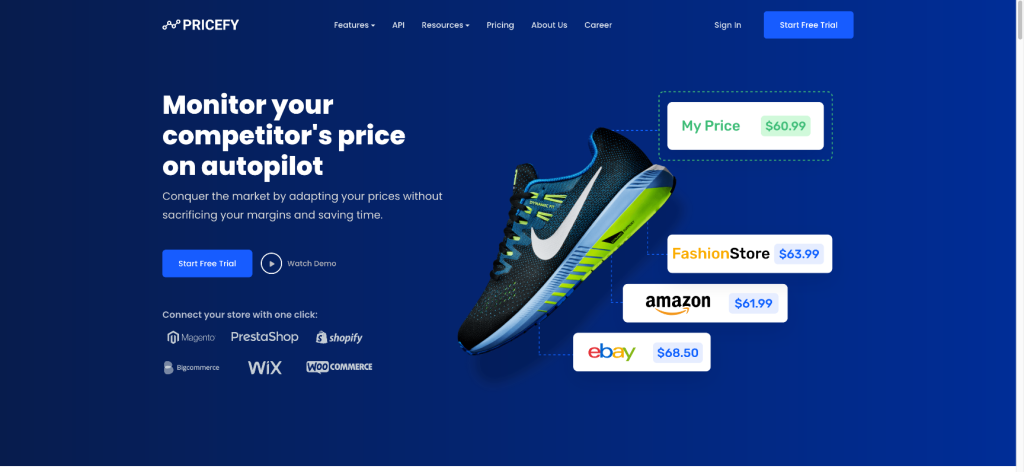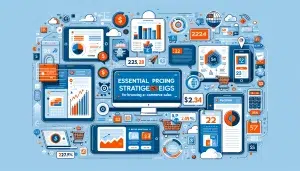
What is Google Shopping Repricing?
This dynamic pricing strategy involves using specialized software tools that analyze market conditions, competitor prices, demand fluctuations, and other factors to optimize product prices. The goal is to ensure that a retailer’s products are competitively priced, thereby increasing visibility, click-through rates, and ultimately, sales.
When consumers search for products on Google, they usually see a carousel of product images, prices, and retailer names at the top of the search results. They are captivating and draw consumers in. And to stand out in that arena, having the right price at the right time is crucial.
Here are ten compelling reasons why retailers should adopt Google Shopping Repricing.
1. Enhances Competitiveness
Retail is a cutthroat industry where being just a few cents cheaper can secure a sale – thats how volatile the ecommerce sales can be. So if you don’t think a couple of cents will matter, you’re wrong. Google Shopping Repricing helps retailers stay competitive by automatically adjusting prices based on real-time market data. This ensures that your products are always competitively priced and repriced, increasing the likelihood of customers clicking on that golden button, the Buy Now box.
2. Boosts Visibility
Google Shopping listings with competitive prices tend to rank higher in search results. By using repricing strategies, your products can achieve better visibility, leading to increased traffic and higher chances of conversion. This enhanced visibility can significantly impact your overall sales volume and brand recognition.
3. Maximizes Profit Margins
While staying competitive is crucial, so is maintaining healthy profit margins. Repricing tools can be configured to ensure prices are adjusted within a certain range, protecting your profit margins. Advanced algorithms consider factors such as minimum acceptable profit levels, competitor pricing, and demand fluctuations to optimize pricing. So you will never find yourself in a situation where repricing of your products goes below your profit line as you determine the parameters.
4. Saves Time
Manual price adjustments are time-consuming and prone to error. Repricing automates this process, freeing up valuable time for retailers to focus on other critical aspects of their business, such as customer service, marketing, and inventory management. Automation ensures prices are updated promptly and accurately, reducing the risk of human error.
5. Improves Inventory Turnover
Holding onto inventory for too long can be costly. Google Shopping Repricing helps in managing inventory more effectively by adjusting prices to move stock quickly. By dynamically changing prices based on demand and stock levels, retailers can reduce excess inventory, improve cash flow, and minimize storage costs. For example if you only have two left of a product, this tool can be set to make sure no discounts are given on the last two items as they are ‘last in stock.’
6. Adapts to Market Conditions
The ecommerce market is constantly changing, with prices fluctuating based on supply, demand, and competitor actions. Google Shopping Repricing tools use real-time data to adjust prices instantly in response to market conditions.
This agility allows retailers to capitalize on opportunities, such as sudden spikes in demand or competitor stockouts, thereby maximizing revenue.
7. Enhances Customer Trust
Consistently offering competitive pricing can enhance customer trust and loyalty. When customers know they are getting the best deal, they are more likely to return to your store for future purchases.
Google Shopping Repricing ensures your prices are always aligned with market expectations, providing a positive perception of your brand.
8. Reduces Price Wars
The last think any retailer wants is a competitor drastically dropping the price and causing an onslaught of price wars. The result can erode profit margins and damage brands.
Repricing tools use sophisticated algorithms to avoid unnecessary price drops. They analyze competitor pricing strategies and make intelligent adjustments that keep prices competitive without engaging in destructive price wars. This strategic pricing helps maintain profitability while staying competitive.
9. Leverages Data Insights
Repricing tools provide valuable data insights and analytics. Retailers can track competitor pricing trends, identify patterns, and make informed decisions based on detailed reports.
These insights can inform broader business strategies, such as marketing campaigns and inventory planning, leading to more effective overall management.
10. Integrates with Other Tools
Modern repricing tools often integrate seamlessly with other ecommerce and retail management systems, such as inventory management, order processing, and customer relationship management (CRM) platforms.
This integration ensures a cohesive approach to pricing and operations, enhancing overall efficiency and effectiveness in managing an online store.
Tips on Repricing Tools
Not all repricing tools are created equal. Retailers should carefully evaluate their options based on factors such as ease of use, integration capabilities with their e-commerce platform, pricing rules, flexibility, and customer support.
Popular repricing tools for Google Shopping Repricing are



Set Clear Pricing Strategies
Before implementing a repricing tool, retailers should define their pricing strategies. This includes determining the desired profit margins, setting minimum and maximum price limits, and deciding on the frequency of price updates.
Having a clear strategy in place ensures that the repricing tool aligns with the retailer’s business objectives.
Analyze Performace Regularly
Regular performance analysis is essential to gauge the effectiveness of the repricing strategy. Retailers should track key metrics such as sales volume, revenue, CTR, and conversion rates. Analyzing this data helps identify areas for improvement and refine the pricing strategy over time.
Leverrage AI and Machine Learning
Advanced repricing tools leverage artificial intelligence (AI) and machine learning (ML) algorithms to optimize pricing. These technologies can analyze vast amounts of data and make predictive pricing decisions based on historical trends and market conditions.
Retailers should consider tools that offer AI and ML capabilities for more sophisticated pricing strategies.
Test and Iterate
Repricing is not a one-time task; it requires continuous testing and iteration. Retailers should experiment with different pricing rules and strategies to find what works best for their products and target audience. Regularly updating and fine-tuning the repricing rules ensures optimal performance.
Focus on Customer Experience
While competitive pricing is important, retailers should not lose sight of the overall customer experience. Factors such as shipping costs, delivery times, and customer service also play a significant role in purchasing decisions.
Retailers should ensure that their repricing strategy complements these aspects to provide a seamless shopping experience.
Case Studies of Google Shopping Repricing Success
Case Study 1
TekSavvy is an online electronics retailer and at any given time, it faces intense competition in the market. With thousands of competitors offering similar products, TekSavvy struggled to maintain visibility and attract customers despite having a robust product lineup.
The company’s primary challenge was ensuring their products were priced competitively without sacrificing profit margins. Manual repricing was labor-intensive and often led to inconsistencies and delays in price updates. In the end, the time spent doing this manually outwayed profits gained.
TekSavvy implemented a Google Shopping Repricing tool to automate their pricing strategy. The tool monitored competitor prices in real-time and adjusted TekSavvy’s prices accordingly while maintaining a predefined profit margin threshold set out by them
The results they experience when utilizing a repricing tool were:
- Increased Visibility – the company’s products started appearing more frequently in the top search results of Google Shopping.
- High Sales – The automated repricing led to a 20% increase in sales within three months.
- Time Savings – Automation reduuced teh time spent on laborous manual price adjustments by 80%, allowing the team to focus on other strategic tasks.
Case Study 2
StylishYou, an online fashion retailer, offers a wide range of clothing and accessories. The fashion industry is highly dynamic, with prices fluctuating frequently due to seasonal trends and competitor actions. The clothing retail industry is as hardcore as the tech industry when it comes to online competition.
StylishYou’s primary challenge was balancing competitive pricing with maintaining healthy profit margins. Frequent price changes manually were not feasible and often resulted in missed opportunities and reduced profitability.
Once they adopted a Google Shopping Repricing solution that used AI algorithms to adjust prices based on real-time market data, it allowed the company to set specific pricing rules, ensuring prices were competitive without undercutting their desired profit margins.
Results experienced with a repricing tool were as follows:
- Improved Profit Margin – Despite aggressive competition, the company managed to increase its average profit margins by 15% over six months.
- Reduced Stock Levels – Efficient pricing strategies meant they were better equipped to clear slow moving inventory and reduce stock levels by 25%.
- Customer Retention – Pricing consistency improved their customer trust and loyalty which was evident in an increase of 10% in repeat purchases.
FAQs
- Q: What is Google Shopping Repricing?
A: Google Shopping Repricing is a dynamic pricing strategy that uses specialized software tools to automatically adjust product prices on Google Shopping. These tools analyze market conditions, competitor prices, demand fluctuations, and other factors to optimize product prices, helping retailers remain competitive and maximize sales. - Q: Why is Google Shopping Repricing important for retailers?
A: Google Shopping Repricing is crucial for retailers because it enhances competitiveness, boosts visibility in search results, maximizes profit margins, saves time, improves inventory turnover, and adapts quickly to changing market conditions. - Q: How does Google Shopping Repricing enhance competitiveness?
A: It allows retailers to automatically adjust their prices based on real-time market data, ensuring that their products are always competitively priced. Even small price differences can secure a sale in the volatile e-commerce market. - Q: Can Google Shopping Repricing help improve my product’s visibility?
A: Yes, Google Shopping listings with competitive prices tend to rank higher in search results, leading to increased visibility, traffic, and higher chances of conversion. - Q: How does repricing impact profit margins?
A: Repricing tools can be configured to adjust prices within a certain range, protecting profit margins while staying competitive. Advanced algorithms consider factors such as minimum acceptable profit levels, competitor pricing, and demand fluctuations to optimize pricing. - Q: Is Google Shopping Repricing time-consuming?
A: No, it actually saves time. Repricing automates the process of price adjustments, which would be time-consuming and prone to error if done manually. This frees up time for retailers to focus on other aspects of their business. - Q: How does repricing affect inventory management?
A: Repricing helps manage inventory more effectively by adjusting prices to move stock quickly based on demand and stock levels. This can reduce excess inventory, improve cash flow, and minimize storage costs. - Q: Can repricing tools adapt to sudden market changes?
A: Yes, Google Shopping Repricing tools use real-time data to adjust prices instantly in response to market conditions, allowing retailers to capitalize on opportunities such as sudden demand spikes or competitor stockouts. - Q: Does using a repricing tool lead to price wars?
A: No, sophisticated repricing tools are designed to avoid unnecessary price drops. They use intelligent algorithms to make strategic pricing decisions that keep prices competitive without engaging in destructive price wars. - Q: What insights can I gain from using a repricing tool?
A: Repricing tools provide valuable data insights and analytics, including competitor pricing trends and patterns. These insights can inform broader business strategies such as marketing campaigns and inventory planning. - Q: Can repricing tools integrate with other e-commerce systems?
A: Yes, modern repricing tools often integrate seamlessly with other e-commerce and retail management systems, such as inventory management, order processing, and CRM platforms. - Q: What are some popular Google Shopping Repricing tools?
A: Some popular tools mentioned in the article include Pricefy, RepricerExpress, and Informed.co. - Q: How should I choose a repricing tool?
A: Evaluate options based on factors such as ease of use, integration capabilities with your e-commerce platform, pricing rules, flexibility, and customer support. - Q: Do I need to set pricing strategies before using a repricing tool?
A: Yes, it’s important to define your pricing strategies, including desired profit margins, minimum and maximum price limits, and the frequency of price updates before implementing a repricing tool. - Q: How often should I analyze the performance of my repricing strategy?
A: Regular performance analysis is essential. Track key metrics such as sales volume, revenue, CTR, and conversion rates to gauge the effectiveness of your repricing strategy and identify areas for improvement. - Q: Do repricing tools use AI and machine learning?
A: Advanced repricing tools leverage AI and machine learning algorithms to optimize pricing by analyzing vast amounts of data and making predictive pricing decisions based on historical trends and market conditions. - Q: Is repricing a one-time task?
A: No, repricing requires continuous testing and iteration. Experiment with different pricing rules and strategies, and regularly update and fine-tune your repricing rules to ensure optimal performance. - Q: How does repricing impact customer experience?
A: While competitive pricing is important, it should complement other aspects of customer experience such as shipping costs, delivery times, and customer service to provide a seamless shopping experience. - Q: Can you provide examples of successful Google Shopping Repricing implementation?
A: The article mentions two case studies: TekSavvy, an online electronics retailer, and StylishYou, an online fashion retailer. Both companies saw significant improvements in visibility, sales, profit margins, and inventory management after implementing repricing tools. - Q: Is Google Shopping Repricing suitable for all types of online retailers?
A: While the article doesn’t explicitly state this, Google Shopping Repricing can be beneficial for a wide range of online retailers, particularly those in competitive markets with frequently changing prices. However, each retailer should evaluate if it aligns with their specific business model and goals.
Summary
Google Shopping Repricing is an essential strategy for online retailers looking to stay competitive and maximize their sales and revenue.
By leveraging automated repricing tools, retailers can ensure that their prices are always competitive, gain valuable market insights, and streamline their pricing processes.
As the e-commerce landscape continues to evolve, adopting dynamic pricing strategies like Google Shopping Repricing will be crucial for online retailers aiming to stay ahead of the competition and succeed in the digital marketplace.




